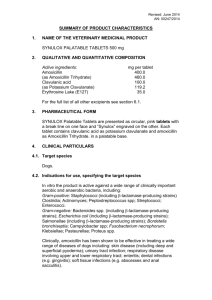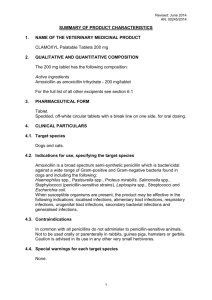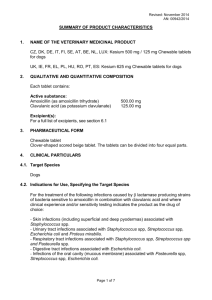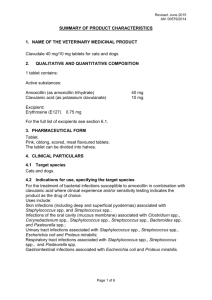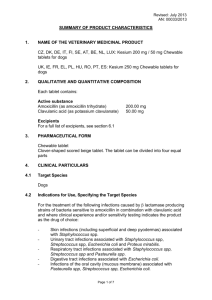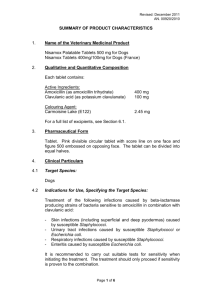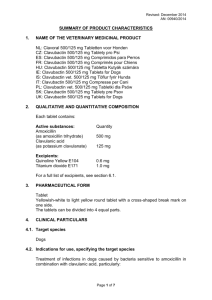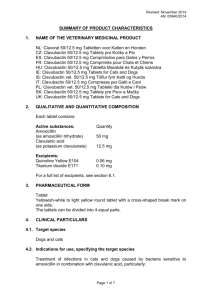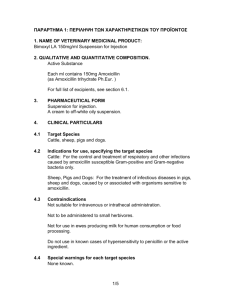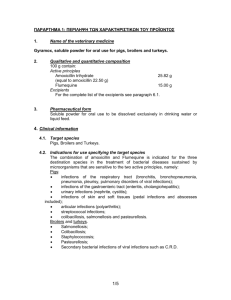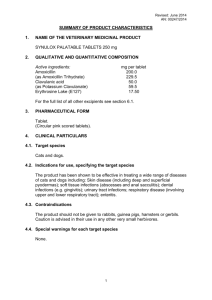Revised: June 2015 AN: 00596/2014 SUMMARY OF PRODUCT
advertisement
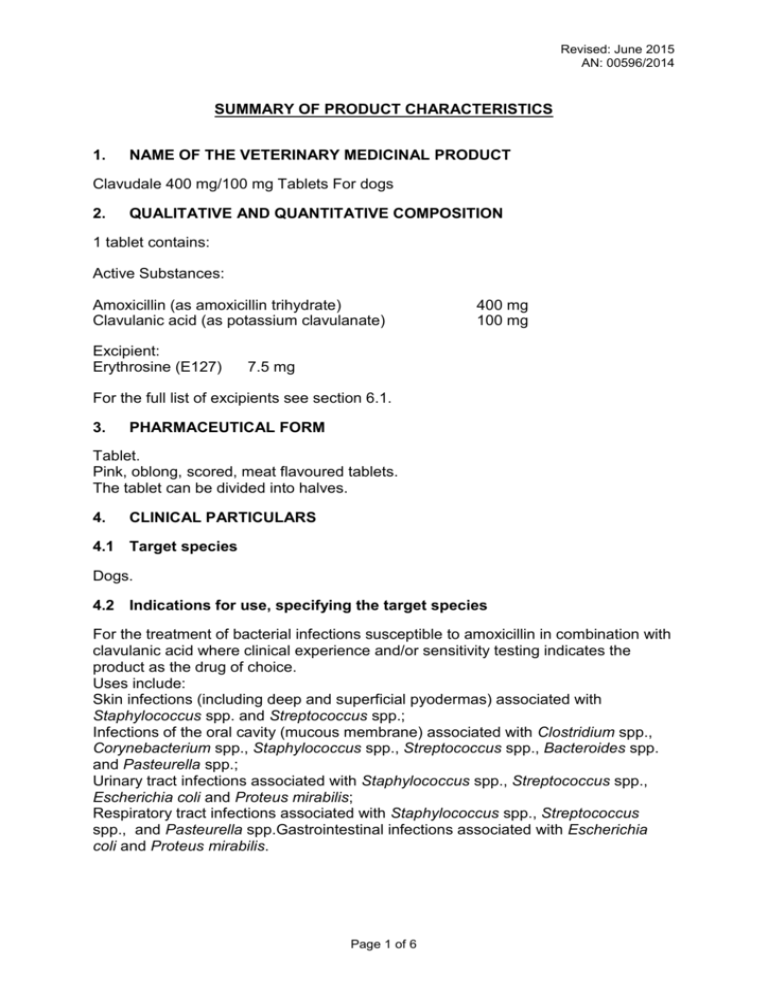
Revised: June 2015 AN: 00596/2014 SUMMARY OF PRODUCT CHARACTERISTICS 1. NAME OF THE VETERINARY MEDICINAL PRODUCT Clavudale 400 mg/100 mg Tablets For dogs 2. QUALITATIVE AND QUANTITATIVE COMPOSITION 1 tablet contains: Active Substances: Amoxicillin (as amoxicillin trihydrate) Clavulanic acid (as potassium clavulanate) Excipient: Erythrosine (E127) 400 mg 100 mg 7.5 mg For the full list of excipients see section 6.1. 3. PHARMACEUTICAL FORM Tablet. Pink, oblong, scored, meat flavoured tablets. The tablet can be divided into halves. 4. CLINICAL PARTICULARS 4.1 Target species Dogs. 4.2 Indications for use, specifying the target species For the treatment of bacterial infections susceptible to amoxicillin in combination with clavulanic acid where clinical experience and/or sensitivity testing indicates the product as the drug of choice. Uses include: Skin infections (including deep and superficial pyodermas) associated with Staphylococcus spp. and Streptococcus spp.; Infections of the oral cavity (mucous membrane) associated with Clostridium spp., Corynebacterium spp., Staphylococcus spp., Streptococcus spp., Bacteroides spp. and Pasteurella spp.; Urinary tract infections associated with Staphylococcus spp., Streptococcus spp., Escherichia coli and Proteus mirabilis; Respiratory tract infections associated with Staphylococcus spp., Streptococcus spp., and Pasteurella spp.Gastrointestinal infections associated with Escherichia coli and Proteus mirabilis. Page 1 of 6 Revised: June 2015 AN: 00596/2014 4.3 Contraindications Do not use in rabbits, guinea pigs, hamsters and gerbils. Do not use in animals with known hypersensitivity to penicillin or substances of the β-lactam group or any of the excipients. Do not use in animals with either oliguria or anuria associated with renal dysfunction. Do not use in cases of known resistance to the combination of amoxicillin and clavulanic acid. 4.4 Special warnings for each target species None known. 4.5 Special precautions for use Special precautions for use in animals Caution is advised on the use of the product in small herbivores other than those listed in 4.3. In animals with hepatic and renal dysfunction, the dosing regimen should be carefully evaluated. Use of the product should be based on susceptibility testing and should take into account official national and regional policies with respect to the use of broad spectrum antibiotics. Do not use in cases of bacteria sensitive to narrow spectrum penicillins or to amoxicillin as a single substance. Use of the product deviating from the instructions given in the SPC may increase the prevalence of bacteria resistant to amoxicillin and clavulanic acid, and may decrease the effectiveness of treatment with other β-lactams, due to the potential for cross resistance. Special precautions to be taken by the person administering the veterinary medicinal product to animals Penicillins and cephalosporins may cause hypersensitivity (allergy) following injection, inhalation, ingestion or skin contact. Hypersensitivity to penicillins may lead to cross-reactions to cephalosporins and vice versa. Allergic reactions to these substances may occasionally be serious. Do not handle this product if you know you are sensitised, or if you have been advised not to work with such preparations. Handle this product with great care to avoid exposure, taking all recommended precautions. If you develop symptoms following exposure such as a skin rash, you should seek medical advice and show the doctor this warning. Swelling of the face, lips or eyes or difficulty with breathing are more serious symptoms and require urgent medical attention. Wash hands after use. 4.6 Adverse reactions (frequency and seriousness) Mild gastrointestinal signs (diarrhoea, and vomiting) may occur after administration of the product. Page 2 of 6 Revised: June 2015 AN: 00596/2014 Allergic reactions (skin reactions, anaphylaxis), blood dyscrasia and colitis may occasionally occur. In these cases, discontinue administration and give symptomatic treatment. 4.7 Use during pregnancy, lactation or lay Laboratory studies in rats and mice have not produced any evidence of teratogenic or foetotoxic effects. No studies have been conducted in pregnant or lactating dogs. Use only according to the benefit/risk assessment by the responsible veterinarian. 4.8 Interaction with other medicinal products and other forms of interaction Bacteriostatic antibiotics (e.g. chloramphenicol, macrolides, sulfonamides and tetracyclines) may inhibit the antibacterial effects of penicillins. The potential for allergic cross-reactivity with other penicillins should be considered. Penicillins may increase the effect of aminoglycosides. 4.9 Amounts to be administered and administration route For oral administration only. The dosage rate is 10 mg amoxicillin/2.5 mg clavulanic acid/kg body weight twice daily. The tablets may be added to a little food. To ensure a correct dosage, body weight should be determined as accurately as possible to avoid underdosing. The following table is intended as a guide to dispensing the product at the standard dose rate of 10 mg amoxicillin/2.5 mg clavulanic acid/kg body weight twice daily. Body weight (kg) > 30 to ≤ 40 > 40 to ≤ 60 > 60 to ≤ 80 Number of tablets twice daily 1 1½ 2 In refractory cases the dose may be doubled to 20 mg amoxicillin/5 mg clavulanic acid/kg body weight twice daily. Duration of therapy: Routine cases involving all indications: The majority of routine cases respond to between 5 and 7 days of therapy. Lack of effect after 5-7 days of treatment necessitates renewed examination. Chronic or refractory cases: In chronic cases, longer courses of antibacterial therapy may be required. In such circumstances overall treatment length is at the clinician’s discretion, but must be long enough to ensure complete resolution of the bacterial disease. 4.10 Overdose (symptoms, emergency procedures, antidotes), if necessary Mild gastrointestinal symptoms (diarrhoea and vomiting) may occur more frequently after overdose of the product. 4.11 Withdrawal period Not applicable Page 3 of 6 Revised: June 2015 AN: 00596/2014 5. PHARMACOLOGICAL PROPERTIES Pharmacotherapeutic group: Beta-lactam antibacterials, penicillins. ATCvet code: QJ01CR02 5.1 Pharmacodynamic properties Amoxicillin is an aminobenzylpenicillin from the β-lactam penicillin family which prevents bacterial cell wall formation by interfering with the final step of peptidoglycan synthesis. Clavulanic acid is an irreversible inhibitor of intracellular and extracellular βlactamases which protects amoxicillin from inactivation by many β-lactamases. Amoxicillin in combination with clavulanic acid has a wide range of activity which includes β-lactamase producing strains of both Gram-positive and Gram-negative aerobes, facultative anaerobes and obligate anaerobes, including: Gram-positives with good susceptibility: Clostridium spp. Corynebacterium spp. Staphylococcus spp. Streptococcus spp.. Gram-negatives with good susceptibility: Pasteurella spp. Bacteroides spp. Proteus mirabilis. Gram-negatives with variable susceptibility: Escherichia coli. Susceptibility and resistance patterns can vary with geographical area and bacterial strain, and may change over time. Amoxicillin/clavulanic acid breakpoints (NCCLS/2012): Staphylococci: sensitive: MIC < 4/2 µg/ml, resistant: MIC > 8/4 µg/ml Other organisms: sensitive: MIC < 8/4 µg/ml, resistant: MIC > 32/16 µg/ml The two main mechanisms of resistance to amoxicillin/clavulanic acid are: Inactivation by those bacterial beta-lactamases that are not themselves inhibited by clavulanic acid, including class B, C and D. Alteration of Penicillin-Binding Proteins (PBP), which reduce the affinity of the antibacterial agent for the target (methicillin resistant S. aureus, MRSA and S. pseudintermedius, MRSP). Impermeability of bacteria or efflux pump mechanisms may cause or contribute to bacterial resistance, particularly in Gram-negative bacteria. Resistance genes can be located on chromosomes (mecA, MRSA) or plasmids (LAT, MIR, ACT, FOX, CMY family beta-lactamases) and a variety of resistance mechanisms have emerged. Pseudomonas aeruginosa and Enterobacter spp. can be regarded as intrinsically resistant to the combination. 5.2 Pharmacokinetic particulars After the oral administration to dogs of the recommended dose of 10 mg amoxicillin/2.5 mg clavulanic acid/kg body weight the following parameters were observed: median Tmax of 1.5 hours for amoxicillin and of 1.0 hours for clavulanic acid. Page 4 of 6 Revised: June 2015 AN: 00596/2014 Amoxicillin is well-absorbed following oral administration. In dogs the systemic bioavailability is 60-70%. Amoxicillin (pKa 2.8) has a relatively small apparent distribution volume, a low plasma protein binding (34% in dogs) and a short terminal half-life due to active tubular excretion via the kidneys. Following absorption, the highest concentrations are found in the kidneys (urine) and the bile, and then in liver, lungs, heart and spleen. The distribution of amoxicillin to the cerebrospinal fluid is low unless the meninges are inflamed. Clavulanic acid (pKa 2.7) is also well-absorbed following oral administration. The penetration to the cerebrospinal fluid is poor. The plasma protein binding is approximately 25% and the elimination half-life is short. Clavulanic acid is mainly eliminated by renal excretion (unchanged in urine). 6. PHARMACEUTICAL PARTICULARS 6.1 List of excipients Erythrosine (E127) Silica, colloidal anhydrous Magnesium stearate Sodium starch glycolate (Type A) Cellulose, microcrystalline Luctarom 31600z additive (meat flavour) 6.2 Incompatibilities Not applicable 6.3 Shelf life Shelf life of the veterinary medicinal product as packaged for sale: 4 years. Shelf life after first opening the immediate packaging: 12 hours. Any divided tablet portions remaining after 12 hours should be discarded. 6.4. Special precautions for storage Do not store above 25ºC. Divided tablets should be stored in the blister pack. 6.5 Nature and composition of immediate packaging Blister packs consisting of orientated Polyamide/Aluminium/Polyvinyl chloride film, heat sealed with aluminium foil (20µm) in strips of 6 tablets. Cartons containing 12 or 24 tablets. Not all pack sizes may be marketed. 6.6 Special precautions for the disposal of unused veterinary medicinal product or waste materials derived from the use of such products Any unused veterinary medicinal product or waste materials derived from such veterinary medicinal products should be disposed of in accordance with local requirements. Page 5 of 6 Revised: June 2015 AN: 00596/2014 7. MARKETING AUTHORISATION HOLDER Dechra Limited Snaygill Industrial Estate Keighley Road Skipton North Yorkshire BD23 2RW 8. MARKETING AUTHORISATION NUMBER Vm 10434/4053 9. DATE OF FIRST AUTHORISATION 08 January 2010 10. DATE OF REVISION OF THE TEXT June 2015 Approved: Page 6 of 6 25/06/2015
